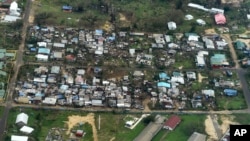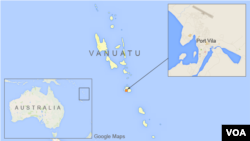Relief workers said Monday the conditions in Vanuatu in the wake of Cyclone Pam are among the worst they have ever seen and the environment is rife for spreading disease.
"I don't think there has ever been destruction on this scale in one place," said Aurelia Balpe, head of the Pacific Office of the International Federation of Red Cross and Red Crescent Societies.
"Friday night was the first emergency with the arrival of Cyclone Pam, disease will be the second emergency without clean water, sanitation and hygiene provision," Oxfam Vanuatu Director Colin Collett van Rooyen said.
"We need food for the coming weeks," said Red Cross Vanuatu CEO Jacqueline de Gaillarde.
Officials in Vanuatu had still not made contact with outlying islands by Monday night and were struggling to determine the scale of devastation from the cyclone, which tore through the nation early Saturday. Authorities have confirmed at least eight deaths and more than 20 injuries.
Bridges were down outside the capital, Port Vila, making travel by vehicle impossible even around the main island of Efate.
Paolo Malatu, coordinator for Vanuatu's National Disaster Management Office, told The Associated Press that officials had dispatched every plane and helicopter they could to fly over the hard-hit outer islands. The office was expecting to get full reports from the flyover crews early Tuesday.
VOA spoke with Derek Brien who is in Port Vila, the capital city, where he works for the Pacific Institute of Public Policy. He said, "Everything has been wiped out" and that is "the most frightening thing because most people here rely on their gardens for food."
Brien said all the fruit trees and crops have been destroyed.
President out of country
Vanuatu President Baldwin Lonsdale said Monday the state of emergency that has been issued is only for Port Vila, where 90 percent of the buildings and houses have been destroyed or damaged. He said another state of emergency will be enacted for the other cluster of islands that make up Vanuatu once communications have been re-established.
Lonsdale called the cyclone "a monster," and said his country must start anew.
"This is a very devastating cyclone that goes to Vanuatu. ... It is a monster. It's a monster that has hit the Republic of Vanuatu. And again it is a setback for the government and for the people of Vanuatu. After all the development that has taken place, all the development has been wiped out. So it means we will have to start new again," he said.
Lonsdale, preparing to return home, was speaking in Japan where he and other government officials were attending a U.N. conference on disaster risk reduction when the cyclone struck Vanuatu.
Vanuatu is located on the geologically active Pacific Ring of Fire. One of the world's poorest nations, it suffers from frequent earthquakes and tsunamis and has several active volcanoes.
Ranked as the country most vulnerable to natural disasters globally, Vanuatu's presence at the conference was undoubtedly warranted. But its unfortunate accident of timing meant key officials were overseas just as the storm hit.
"We had a warning before we left, but the wind was still developing, it had not intensified," Lonsdale said Monday. "When it developed to become a cyclone, we had already left the country. We did not realize how bad it was going to be."
Part of the problem was a late change in direction that put Pam on a collision course for Vanuatu, but meteorologists said the severity of the storm was widely expected.
Relief workers were struggling Monday to contact the more than 80 islands that make up Vanuatu to determine the impact of the cyclone that struck late Friday and Saturday. Relief supplies began flowing into the stricken country Sunday.
"I was present for the Haiyan response and I would 100 percent tell you that this is a much more difficult logistical problem," said Tom Skirrow, Save the Children's Vanuatu director, referring to the 2013 Super Typhoon Haiyan that hit the Philippines and left more than 7,000 people dead or missing.
Cyclone Pam, with winds up to 300 kph, destroyed entire villages, reducing buildings to timbers and tearing off rooftops, downing power lines and toppling trees.
Aid workers said virtually every building not made out of concrete has been flattened.
Oxfam's van Rooyen told Reuters a 6 p.m. to 6 a.m. curfew had been imposed in the capital to prevent looting. He said there have been unconfirmed reports of minor looting of hardware equipment.
Reaching outer islands
While authorities have confirmed at least eight deaths, they said the toll is expected to rise sharply as rescuers reach the most remote islands in the archipelago, which lies about a quarter of the way from Australia to Hawaii.
Vanuatu has a population of about 250,000 people spread over more than 80 islands. About 45,000 people live in the capital.
UNICEF said the cyclone affected at least half the population of Vanuatu, including about 54,000 children.
A U.N. statement on a meeting between U.N. Secretary-General Ban Ki-moon and President Lonsdale on the sidelines of the Japan conference quoted the U.N. chief as saying Vanuatu "has already been suffering from the adverse effects of climate change." He said "storms such as Pam only increase the challenges that the country faces."
Other Pacific islands were also damaged by Pam, including Kiribati and the Solomon Islands.













